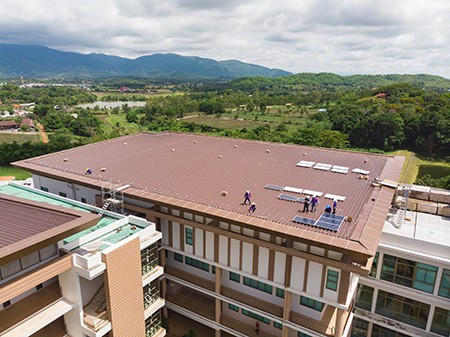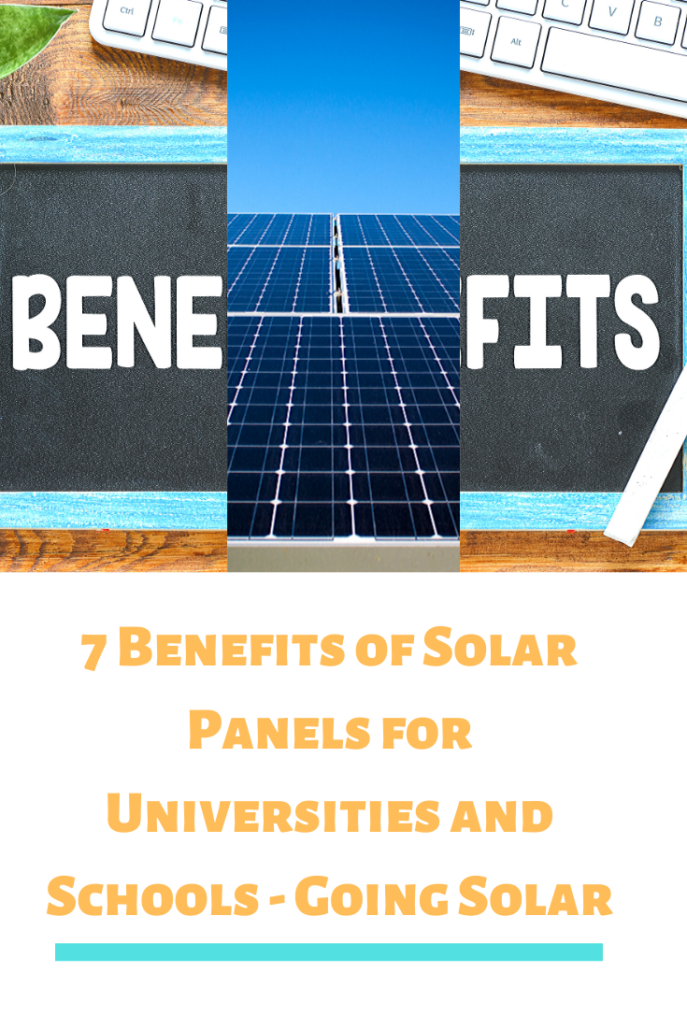Solar energy goes well with smart technology and education.

It’s an ideal energy source for powering cost-conscious and eco-friendly facilities that serve thousands of people. Universities are centers for cutting edge knowledge and pathways to the future. Clearly, solar has a bright future since it cuts energy costs, reduces current greenhouse gas emissions and provides a sustainability design.
Here are major benefits to installing solar panels on universities and other schools.

1. Free Energy from the Sun
Once the equipment to produce solar cells is paid for, free energy from the sun will eventually offset installation and material costs, leading to a return on investment within a matter of years. Unlike a home solar array, which can only allow a certain number of panels due to the limitations of roof space, universities have broad structures that can accommodate hundreds of panels, which can power an entire campus. The more panels you install, the more unlimited free energy you can produce.

2. Sustainability Goals Boost Credibility
The fact that solar is an unlimited energy source alone makes it more environmentally friendly than finite fossil fuel energy sources. Using up the earth’s natural resources through drilling and blasting puts a strain on the environment and creates ripple effects involving pollution and health concerns. Sustainability has become a buzz word in the corporate world as well as the government and solar panels are here to stay. The more an institution embraces renewable energy, the better its image will be with the community.

3. Independent Power Source
While PV systems can serve as standalone energy sources, they are typically integrated with the traditional grid system as backup power. Alternative colleges and universities that invest solar power (NOTE: should be “invest in solar power”) can operate outside of the traditional grid system, which may be helpful during a utility power outage. Just like how solar power companies deliver clean energy electricity to residential homes, universities can operate as independent energy hubs for their campuses. In cases of natural disaster, a solar array can help improve emergency response and provide backup power until local utility power is restored. With the rise of several solar plants that generate several megawatts or gigawatts of power, it’s possible for solar energy to eventually be 100 percent renewable and completely independent of the grid.

4. Opportunity for Press Coverage
Universities that consistently experiment with new solar developments such as Stanford or MIT are routinely covered by the media, particularly publications that specialize in alternative energy. By building money-saving solar arrays and giving a name to your solar installation such as “Project Solar Energy,” a university can get positive press, which may attract big investors who want to enhance the quality of their communities. They understand to invest solar power (NOTE: should be “invest in solar power”) now means big energy cost savings in the future as well as providing clean energy electricity, which promotes a healthier environment.

5. Low Maintenance
Another major benefit to solar panels for alternative colleges and universities is that once they are installed they don’t need much maintenance. The glass and frame that protects solar cells are very strong and durable. Certain panels are strong enough to withstand hurricanes. Most modern solar panels are designed to last at least 25-30 years, but it’s possible to last longer in mild climates. One of the keys to panels being low maintenance is that they don’t have any moving parts. Both a university or home solar array must be periodically inspected, but in warmer climates solar panels have more longevity. The panels can be damaged by wind and other severe weather conditions, but tend to be unbreakable.

6. Green Energy Attracts Millennials
Millennials overwhelmingly favor green energy, so installing solar panels on a university roof could help increase enrollment. Tax credits from the government and solar panels produced cheaply are two environmental topics that have drawn interest from young people who want to participate in project solar energy. Even eco-minded students who cannot afford panels want to learn how to install own panels to prepare for the future. (NOTE: should be “their own solar panels”) Current greenhouse gas emissions suggest that society needs to convert to renewable energy in the next few decades to avoid extensive irreversible damage to the environment. For this reason, young people see sustainability design as essential for the planet’s survival.

7. Solar Works Well on Flat Roofs
Most universities are built with flat rather than sloped rooftops, making them ideal for easy solar panel installation. Students who want to install own solar panels (NOTE: should be “their own solar panels”) on flat roofs can learn directly from university authorities on how it’s done. They can apply some of this knowledge to sloped roofs with the understanding that sloped roofs need to be facing south and free of shade to get adequate sunlight. Flat roofs are more convenient for universities and large structures that include HVAC and other roofing equipment.
Conclusion
As solar power companies continue to build vast solar arrays to power stadiums and big office complexes, alternative colleges and universities are also playing an influential role in the conversion to sustainable design. The reason why it’s significant that campuses are going solar is that they tend to cover plenty of land and serve thousands of people. By setting examples for adopting solar as financial and environmental necessities, more organizations within the community will be inspired to join the clean energy revolution as well.
Stanford University has set an impressive goal to use 100 percent solar energy by 2021. The campus has already built the first of two solar generators that will achieve this goal, which is on a faster trajectory than the state of California’s goal to have a carbon-free grid by 2045. The second plant will be off-campus and sell affordable energy to the campus. The university has already reduced greenhouse gas emissions by 66 percent from peak levels with its first 67-megawatt station launched in 2016 and 5 additional megawatts on campus roofs, introduced in 2017. The plan was initiated in the 2008-2009 school year. Since then solar technology has improved significantly, which means universities looking to venture into solar now will have even more favorable conditions to plan solar arrays. Other major universities investing in solar development include Princeton, Northwestern University, University of Arizona, Drexel University and Colorado State University.
According to the U.S. Department of Energy, taxpayers spend $6 billion annually on grade schools, which are far more numerous than colleges. Imagine the dramatic savings if smaller schools follow the lead set by major universities going solar and install own solar panels (NOTE: should be “their own solar panels). Cost savings can be realized for heating, cooling, lighting, ventilation and operating electronic equipment.
